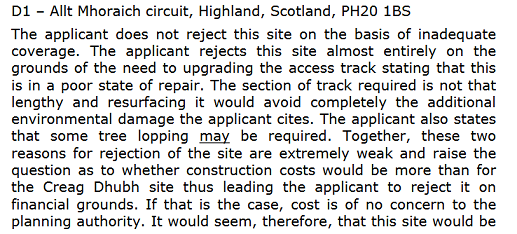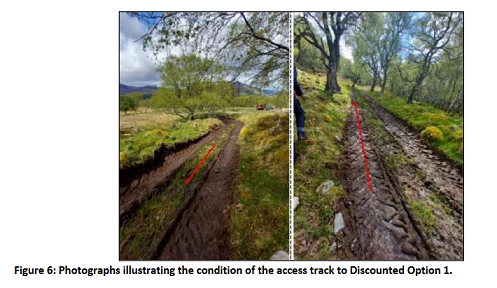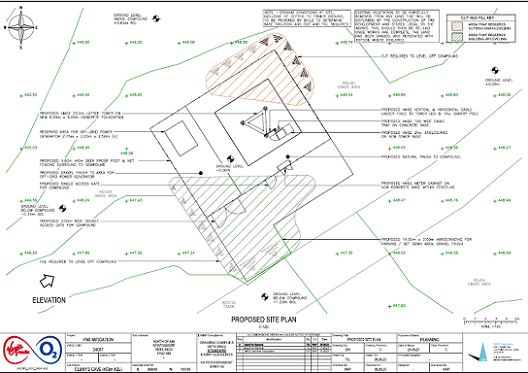In May, in a welcome move, Highland Councillors rejected the recommendation of their officers to approve a 25m high telecommunications mast on the south facing slopes of Creag Dubh, above the A86 between Laggan and Newtonmore, and refused planning permission on the grounds that:
“This proposed installation of a telecommunications mast is considered contrary to policy 6
of the Cairngorms National Park Authority Local Development Plan and policy 24 (e) (ii) of
NPF4 as the Applicant has failed to provide robust evidence in support of their application
that demonstrates the possibility of mast and site sharing.”
A month ago WHP Telecoms, acting on behalf of Mobile Providers 02 and the Shared Rural Network, submitted an appeal against Highland Council’s decision to the Scottish Government (see here for planning papers and to submit a comment – the closing date for submissions is 13th August).
The appeal provides an opportunity for the Scottish Government Reporter appointed to consider the case to bring some much needed sense to the ill-conceived Shared Rural Network programme, as featured in previous posts. This has resulted in a spate of completely unnecessary and unwanted proposals, including Creag Dhubh (see here, here and here for previous posts) and most recently the proposed mast at Ryvoan and its “repeater” in Glenmore (see here). Under planning law the Reporter is not just limited to considering the reasons the application was refused by Highland councillors and the developers grounds for appeal but can consider matters afresh, including those previously raised on parkswatch
An unnecessary and unjustifiable mast
WHP Communication’s main justification for the proposed mast on Creag Dhubh is its predicted coverage:

This map should raises serious doubts about WHP’s claim to the reporter that “existing masts in the area would not provide suitable coverage in their target area due to their distance and lower elevation” (para 6.21 in its appeal statement) . If the existing EE Mast, 4.5km away, at Catlodge cannot provide “suitable coverage” to areas beyond that distance but in line of site of it, how will the proposed O2 mast provide “suitable coverage” to places on the map that are 15km away?
Far more significant than the map provided is the lack of any maps showing existing coverage from other providers, a point highlighted by Highland Council in their response to the appeal:
“Although it is recognised that the Applicant [i.e WHP} has provided evidence of the coverage that the proposal will extend to, no evidence has been provided that illustrates what the existing mast areas cover and any overlap with the target area. It is respectfully submitted that any assessment of the
need and as such the benefit of such a proposal should include an evaluation of what the
existing site masts cover and to what extent (if any) that it overlaps with the proposed target
area in terms of this proposal.”

The North East Mountain Trust (NEMT) in their response to the appeal (see here) plugs the gap with a detailed analysis by parkwatch contributor David Craig. He looks at existing coverage from 02 and EE masts in the area and concludes, from the information that is publicly available, that the EE mast at Cat Lodge could, if shared, eliminate the small “partial not spots” in O2 and Vodafone coverage. David magnaminously recommends an independent assessment of exiting coverage but in my view the information he has provided should in itself be sufficient for the reporter to dismiss WHP’s appeal..
The basic issue here (like at Ryvoan where Three is proposing to erect its own mast “repeater” mast without reference to O2’s mast at Lanchoil) is that the mobile operators are not co-operating and failing to consider the potential to share masts. This is contrary to much existing policy, including the guidance NatureScot issued last year on masts in National Parks, National Scenic Areas and Wild Land Areas (see here) :
“The Design Statement should include a clear demonstration for the reasons for site selection.
This should explore options for site selection and provide justification for a new ground based
mast over utilising an existing mast or structure, replacing an existing mast and/or site sharing”.
The most likely explantion for O2 to want to erect a new mast, costing approximiately £1m, in preference to sharing an existing EE mast, is that the mobile operators are charging each other excessive rents for sharing masts and far more than what landowners are charging. WHP’s claim in the appeal that “the SRN programme is a sustainable approach to the challenge of delivering rural mobile coverage” is completely unfounded. This problem is something that Peter Kyle, the UK Government Minister now responsible for the Shared Rural Network programme, needs to address. Perhaps it is time to nationalise mast provision to eliminate partial not spots in order to make sustainable use of resources?
Besides failing to explain why 02 cannot share EE’s mast at Cat Lodge, WHP rejects an alternative location on the Allt Mhoraich on the grounds that the track to it is in a poor state of repair. As NEMT points out the argument is extremely weak:

As further evidence for NEMT’s argument it is worth considering photos provided by WHP along with their appeal:


Now consider the appelant’s response to concerns raised by Laggan Community Council about the:
“lack of information about how the access track, a popular route of ascent up Creag Dubh, would be upgraded, just that it would be used by ATV’s for infrequent service visits to the mast”.
WHP “It was advised and confirmed as part of the application that the existing access track does not require any upgrade works”.
This is simply not credible. The existing track up Creag Dhubh is far too narrow and its surface unsuitable for transporting up the materials needed to construct a 25m mast and all the other associated infrastructure.

And while the track might be usable by ATVs for maintenance purposes, why then does the site map (above) include provision for a 3m wide gate?
The Scottish Government reporter needs to consider afresh the extent to which the documents submitted by the appellant accurately describe the extent of the development. That should also include – a point that Laggan Community Council raised but has never been addressed – how electricity will be provided to the site (WHP refers to a back-up generator but does not explain how the mast would normally be powered).
The landscape impact of the proposed development
WHP tries to claim that the proposed mast will blend in to the hillside behind it (making great play of the fact its below the ridge). However, instead of providing proper photomontages, WHP supplies blank photos from a limited number of viewpoints (along with computer generated “wire frame” graphics which add nothing more):

This makes it exceedingly difficult for the Reporter to assess properly the visual impact of the proposed mast. BUT, whatever its impact, the overall landscape impact of the proposed development has not been properly assessed. This is because of the omission of the powerlines and the need to upgrade the existing track both of which are likely to be highly visible as they cross the open hillside shown above.
WHP tries to use the decision of the Cairngorms National Park Authority (CNPA) not to call-in this planning application because it did “not raise any planning issues of general significance to the park aims” as a reason why no-one should be concerned about the landscape and other potential impacts of this application. The response from Highland Council to this is really important:
“While it is recognised that the Cairngorms National Park Authority, as a statutory consultee, raised no objections to this application, it is respectfully submitted that the Committee, as the planning authority, has the authority to reach a different conclusion in their assessment of the application. The Committee found the Appellant’s lack of robust evidence supporting the need for the installation of a new mast to be compelling enough to justify a departure from the statutory consultee’s view.“
In other words the view of Highland Council is that CNPA planning officers got their assessment in this case wrong, the application does raise issues of significance about the Park’s aims and their councillors were brave enough to say so. In support of Highland Council it is worth emphasising that CNPA has a statutory duty to protect all the landscape within the National Park and there is evidence that their officers have been failing to do that recently – as I showed in my post yesterday on HIE’s proposal to create a playpark at Cairn Gorm (see here).
Creag Dhubh also lies within the Ben Alder, Laggan and Glen Banchor Special Landscape Area (SLA), a fact that WHP fails to mention in their appeal. While the CNPA does not explicitly recognise SLAs, a council designation, in their Local Development Plan it does provide additional official acknowledgement of the importance of the landscape and that unnecessary masts, such as this, should be avoided at all costs. It also helps to WHP’s attempt to use an Inspector’s decision at Bradwell-on-Sea down in England to justify the grounds of their appeal: the landscape where the masts are located are totally different, have different values and the situations are therefore not comparable.
In trying to justify the mast on landscape grounds, WHP also quote from the report to Highland Council Planning Committee:
“The proposal is not considered to be significantly detrimental to amenity and it has been
demonstrated that the proposal is appropriately sited and designed and that landscape impacts will not be significant.”
While Highland Council did not reject that argument from their staff in refusing the application that doesn’t make it right.. The main amenity at stake in this case is that of people, whether local residents or visitors, walking up to track to Creag Dhubh. Whatever the landscape impact from a distance, the mast and all its clutter will have a serious detrimental affect on this experience and that impact will be even greater if the track is upgraded and power lines installed. The Scottish Government should be listening to local communities and communities of interest – represented by organisations like NEMT – about the affect these masts have on amenity, not planning officers sitting at their desks.
Other reasons to refuse the appeal
While both Scotland and the UK are now supposed to be on a journey to reduce carbon omissions and National Planning Framework 4 makes this a material consideration for ALL planning applications, WHP has made no attempt to assess the carbon impact of this mast. Although NPF4 won’t have much bite until every development is required by planners to calculate its carbon emissions, it should be obvious that building extra masts because mobile operators aren’t prepared to share existing ones should be unacceptable from a climate change perspective.
The proposed mast is within a Site of Special Scientific Interest, which is why it requires full planning permission, and WHP quotes NatureScot’s response to the original application in order to try and minimise its impact on the natural environment:
‘While the compound and access both lie within the designation, neither lie within qualifying
upland birch woodland, instead affecting wet heathland and blanket bog. NatureScot are
therefore content that the proposal will not result in any damage to the designated feature of
Creag Dhubh SSSI.’
NatureScot’s response, as I have previously commented, begs the question of why land which does not meet the qualifying features of the Creag Dhubh SSSI was included if the intention was not provide a protective ring around the birch woods or create space for them to expand. But the reference to blanket bog is significant. Nowhere does WHP explain how much peatland will be affected by the proposed development or the amount of carbon that will be emitted as a consequence. The Scottish Government’s reporter should ask themselves why NatureScot and the CNPA, which together are administering the £250m to restore damaged peatland, have taken so little interest in a development which will damage peatland unnecessarily.
Responding to the appeal
My understanding is that a number of individuals have responded to WHP’s appeal. Unfortunately, their responses have not yet been published on the website of the DPEA, the Scottish Government division that handles appeals.
Unfortunately, the DPEA website makes it very difficult for the public to lodge objections to applications, with a much clunkier process than that used by planning authorities. It is important, however, that people continue to try to do so before the deadline of 13th August so that the Reporter gets some idea of the level of public concern about this mast and the whole disastrous SRN programme. . So, if you have time, please click on the link to the application here, register (you will need to download an authentication app if you don’t have one) and add a comment. If nothing else, even registering that you support NEMT’s excellent submission to the appeal would help.

I have simply emailed the DPEA with my comments. Will that be sufficient?
I too have emailed the DPEA, having found it impossible to lodge comments online – the case officer is Rebecca.Brown2@gov.scot
I didn’t have any luck with the DPEA’s silly system either and have now emailed Rebecca Brown. Thanks, Nick!